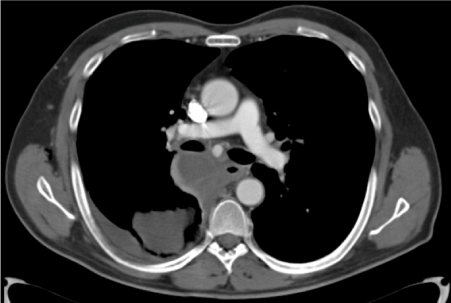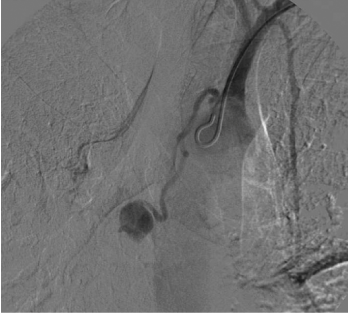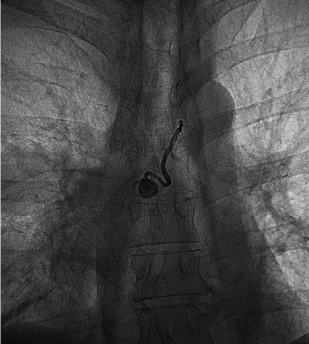Case Report Open Access
Transcatheter Bronchial Artery Aneurysm Embolization with Onyx
| Mario Corona, Antonio Bruni, Chiara Zini*, Emanuele Boatta, Fabio Coratella, Jacopo Tesei, Paolo Rabuffi, Carlo Cirelli, Fabrizio Fanelli and Filippo Maria Salvatori | |
| Vascular and Interventional Radiology Unit, Radiology, Oncology and Pathology Department, Sapienza- University of Rome, Viale Regina Elena 324 00161, Rome, Italy | |
| Corresponding Author : | Chiara Zini Vascular and Interventional Radiology Unit Radiology, Oncology and Pathology Department Sapienza- University of Rome Viale Regina Elena 324 00161, Rome, Italy Tel: +39-064455602 / 064468587 Fax: +39-06490243 E-mail: zini.chiara@gmail.com |
| Received July 16, 2013; Accepted September 10, 2013; Published September 17, 2013 | |
| Citation: Corona M, Bruni A, Zini C, Boatta E, Coratella F, et al. (2013) Transcatheter Bronchial Artery Aneurysm Embolization with Onyx. OMICS J Radiology 2:145 doi: 10.4172/2167-7964.1000145 | |
| Copyright: © 2013 Corona M, et al. This is an open-access article distributed under the terms of the Creative Commons Attribution License, which permits unrestricted use, distribution, and reproduction in any medium, provided the original author and source are credited. | |
Visit for more related articles at Journal of Radiology
Abstract
Purpose: Report a case of transcatheteral embolization of a Bronchial Artery Aneurysm (BAA) using Onyx. Case report: A 60 years-old man was hospidalized because mediastinum hematoma related to BAA. Left transsucclavian approach was conducted and the microcatheter was used to reach the BAA. Because vessel caliper and tortuosity aneurism packing was not possible, so why Onyx 34 was released as close as possible to the aneurysmatic sac with “plug and push” technique. The clinical condition of the patient immediatly improved and the 1-month CTA confirmed the complete exclusion of BAA; patient did not claim any particular disturbs after 7-month follow-up. Conclusions: Embolization of BAA using Onyx 34 is feasible and viable.
| Keywords |
| Bronchial artery aneurysm; Embolization; Onyx; Endovascular approch; Trancatheter embolization; Hemomediastinum |
| Introduction |
| Bronchial Artery Aneurysm (BAA) is a rare entity, reported in less than 1% of all selective bronchial arteriograms [1]. BAA etiology is unknown but it has been described an association with chronic inflammatory lung disease, infective diseases and trauma [2-4]. |
| BAA can be located in the intraparenchymal bronchial branches leading to hemoptysis or in the mediastinal segment with symptoms related to the compression or rupture into contiguous structure [1-4]. |
| Due to its rarity BAA treatment has not yet standardized. Therapies options are up to patient condition and operator ability so why surgery, endovascular techniques or both have been described as therapeutic options for BAA [1-7]. |
| The present case reports the first Bronchial Artery Embolization (BAE) with Onyx 34 (Micro Therapeutic Inc., ev3 Neurovascular, Irvine, CA, USA). |
| Case Report |
| A 60 years-old man was hospitalized because chest pain after seatbelt fastens. An angiography with Computed Tomography (CTA) was performed in order to evaluate a possible aortic rupture. |
| Mediastinum hematoma (8 cm×4 cm) with BAA was reported in CTA (Figure 1) and endovascular approach was preferred to surgical one because patient instability. |
| The Digital Subtraction Angiography (DSA) described an enlarged left bronchial artery (3 mm) with a BAA (2 cm), just below the carina level, with direct inflow from an aberrant right bronchial artery, originated next to the left subclavian ostium (Figure 2). |
| A left trans-succlavian approach was conducted with guiding catheter (UF 4F, Cordis, Miami Lakes, FL, USA) then the microcatheter (Prograte alfa 2.7F, Terumo, Japan) was used to reach the BAA. |
| The aneurism was unpacking because of vessel caliper and tortuosity, so why we decided to embolize with Onyx 34 because its capability of occluding feeding vessels, preventing retrograde filling of the aneurysm. In order to avoid vessel dissection, Onyx was released as close as possible to the aneurismatic sac with “plug and push” technique [8]. A safe injection rate of dimethyl sulfoxide (DMSO) <0.14 mL/min longer than 40 seconds was performed in order to avoid vasospasm and necrosis. The control angiogram showed complete exclusion of BAA (Figure 3). |
| No endoleak and mediastinum hematoma regression were reported in the CTA, performed one month later (Figure 4). The patient did not report any particular discharges after 7-month followup. |
| Discussion |
| Few cases of hemomediastinum because of BAA have been reported in literature with different therapeutic approaches depend mainly on patient comorbidities, bronchial artery anatomy. |
| Surgical approach, basically consists in open ligation of BAA can be also associated with endovascular approach [5-6]. |
| BAE can be performed with gelatine sponge, detachable coils, steel coils, glue and N-butyl-2-cyanoacrylate and combined treatment [1,7,8]. Whatever embolic material is used, most authors emphasize the importance of occluding not only the feeding vessels but also efferent branches to avoid retrograde filling of the aneurysm [9]. |
| We decided to treat our patient using an endovascular approach because he was unsuitable for surgery. Gelatine sponge was discarded because it offers a temporary embolization while detachable coils were abandoned because of vessel tortuosity. We used Onyx 34, a biocompatible injectable liquid polymer, with “push and plug” technique to get distal distribution of the embolic agent [8,9]. Onyx was initially injected as slow as possible, allowing the formation cast around microcatheter tip with a small amount of reflux; ones an adequate plug was form, Onyx was injected in a control fashion to form a lava-like mass, which follow the feeding vessel, allowing a complete exclusion of the BAA confirmed after seven-month follow-up. |
| Conclusion |
| Onyx 34 could be used as embolic agent in selected cases of BAA. |
References |
|
Figures at a glance
 |
 |
 |
 |
| Figure 1 | Figure 2 | Figure 3 | Figure 4 |
Relevant Topics
- Abdominal Radiology
- AI in Radiology
- Breast Imaging
- Cardiovascular Radiology
- Chest Radiology
- Clinical Radiology
- CT Imaging
- Diagnostic Radiology
- Emergency Radiology
- Fluoroscopy Radiology
- General Radiology
- Genitourinary Radiology
- Interventional Radiology Techniques
- Mammography
- Minimal Invasive surgery
- Musculoskeletal Radiology
- Neuroradiology
- Neuroradiology Advances
- Oral and Maxillofacial Radiology
- Radiography
- Radiology Imaging
- Surgical Radiology
- Tele Radiology
- Therapeutic Radiology
Recommended Journals
Article Tools
Article Usage
- Total views: 13936
- [From(publication date):
October-2013 - Aug 23, 2025] - Breakdown by view type
- HTML page views : 9319
- PDF downloads : 4617
